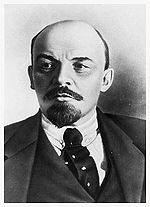Russian Revolution
The term Russian Revolution can refer to two separate events. The first revolution was attempted in 1905, but was unsuccessful. It began with "Bloody Sunday", a peaceful protest for improvements to working conditions. The protesters were gunned down by soldiers. It did, however, lead to the formation of a parliament with limited powers, known as the Duma.
The second, successful revolution, was a series of socio-economic upheavals in Russia in 1917, leading ultimately to the Russian Civil War. The Revolution occurred in two phases: the February Revolution and October Revolution. As a result of the revolution, Russia withdrew from the Allied Powers. The repressive Communist Party overthrew the provisional Kerensky government which was in the organizational stages of a democracy.
The Great War had weakened Tsar Nicholas II, and he abdicated the throne in March 1917. Russia was left under the provisional government of Alexander Kerensky, which intended to continue fighting in the war, but in November 1917, the Bolshevik Communist Party, led by Vladimir Ilyich Lenin, overthrew the provisional government and executed the Czar's family.
Lenin made peace with Germany and then withdrew Russia from the war. In March 1918, Lenin signed the Treaty of Brest-Litovsk, which granted Germany many territories, including what is now Poland, Finland, Lithuania, Ukraine, Estonia, and Latvia. This was a humiliating defeat, but Russia was simply too weak to fight anymore.
The Russian revolution was essentially a Socialist revolution. Lenin preferred to call his government a Communist government though the term meant very much the same. In fact Russia became known as the Union of Soviet Socialist Republics. However, Lenin and his colleagues completely discarded the idea of a democratically controlled society and instead set up what they called the Dictatorship of the Proletariat which was in fact nothing more than a dictatorship by the Communist Party, a tiny fraction of the population. It was in fact a dictatorship by technicians and managers formed into a nomenklatura or elite, the so-called experts in the Socialist organization.
There was a civil war in Russia from 1918 to 1920 between Lenin's Red Army and the opposing western White Army. Ten million people died in the war and five million died in the resulting famine. The Red Army won.
After the civil war, Russia was in economic ruins. Lenin announced his New Economic Policy (NEP) to restore trade and industry to the county. The NEP permitted some capitalism to create incentives, and it allowed some foreign investment. Peasants were permitted sell surplus crops. Profits by merchants were allowed. But government still controlled all major industries. The private ownership only applied to small factories, farms and stores.
A failed assassination attempt on Lenin in August 1918 by a member of a rival revolutionary party led to the 'Red Terror'. Stalin convinced Lenin and other Bolshevik members that a policy of "open and systematic mass terror" against those who were seen as responsible for the shooting would be required. It is estimated that over 200,000 people were executed from 1918 to 1922 as a result of this policy.
Politically, Lenin established the Union of Soviet Socialist Republics (USSR) in 1922, allowing one central government under Lenin to control many socialized republics. In 1924, the Bolsheviks began calling themselves “Communists”. But there was only one political party, and it held all the power. It was the Communist Party.
Russian Revolution and the expansion of atheism
See also: Atheism and communism
According to the University of Cambridge, historically, the "most notable spread of atheism was achieved through the success of the 1917 Russian Revolution, which brought the Marxist-Leninists to power."[1]
Karl Marx said "Religion is the opium of the people".[2] Marx also stated: "Communism begins from the outset (Owen) with atheism; but atheism is at first far from being communism; indeed, that atheism is still mostly an abstraction."[3]
Vladimir Lenin similarly wrote regarding atheism and communism: "A Marxist must be a materialist, i. e., an enemy of religion, but a dialectical materialist, i. e., one who treats the struggle against religion not in an abstract way, not on the basis of remote, purely theoretical, never varying preaching, but in a concrete way, on the basis of the class struggle which is going on in practice and is educating the masses more and better than anything else could."[4]
Friedrich Engels wrote of atheistic evolutionism and communism: "Just as Darwin discovered the law of development of organic nature, so Marx discovered law of development of human history."[5]
See also
References
- ↑ Investigating atheism: Marxism. University of Cambridge (2008). Retrieved on July 17, 2014. “The most notable spread of atheism was achieved through the success of the 1917 Russian Revolution, which brought the Marxist-Leninists to power. For the first time in history, atheism thus became the official ideology of a state.”
- ↑ Marx, Karl. 1976. Introduction to A Contribution to the Critique of Hegel’s Philosophy of Right. Marx-Engels Collected Works, vol. 3. New York.
- ↑ Marx, Karl. Private Property and Communism, 1844.
- ↑ Lenin, Vladimir Ilyich. The Attitude of the Workers' Party to Religion, 1909.
- ↑ Engels, Friedrich. "Karl Marx's Funeral", Marx-Engels Collected Works, vol. 24, p. 467.
